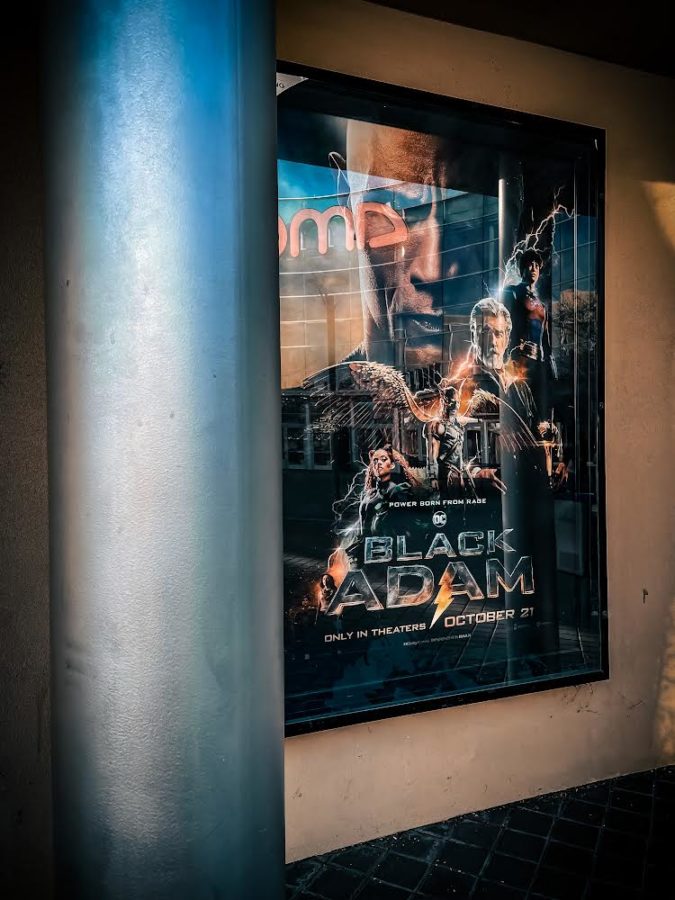DC Comics’ Black Adam is Finally Here — With a Vengeance
Art/Photo by Ph
DC Comics’ Black Adam was released domestically on Oct. 21 starring Dwayne Johnson as Teth Adam, Noah Centineo as Atom Smasher, Pierce Brosnan as Doctor Fate, Aldis Hodge as Hawkman, and Quintessa Swindell as Cyclone. Commenting on his overall experience, West High student and moviegoer Ethan Lam (10) recounted that “compared to other DC movies, Black Adam was better.” Lam’s enthusiasm lends credence to the resounding success the latest DC installment has had at the box office, holding the top spot for over two consecutive weeks.
November 16, 2022
The DC Comics’ live-action film adaptation, Black Adam, has finally hit the silver screen after more than a year of anticipation due to multiple setbacks by the pandemic. Dwayne “The Rock” Johnson takes on the role of Teth Adam, the film’s ostensible anti-hero who hails from Khandaq, a fictional kingdom in the Middle East. A former slave imbued with godlike powers, Teth Adam wakes up from a 5000-year imprisonment after being sentenced by the “Council of Wizards” from whom he derives his abilities from.
The film garnered considerable success, with Black Adam earning $67 million on opening weekend and currently grossing over $250 million worldwide. By its second weekend, Black Adam saw a slightly steeper drop in earnings than other comparable DC Comics films, namely, Aquaman (2018) and Shazam! (2019). However, the film bested the box office earnings of the romantic comedy Ticket to Paradise, which was also released in late October and earned a respectable weekend opening of $16.5 million.
The film follows the titular character as he dispenses an unorthodox version of justice while adjusting to modern-day Kahndaq, a far cry from the ancient kingdom it was in 2600 B.C.E. Despite the urbanization of Kahndaq — a bustling city with aging beige buildings, seemingly anachronistic flying motorbikes, and a monumental statue paying tribute to Teth Adam — there are some less desirable continuities that persist in the region. The perpetually oppressed people of Kahndaq currently live under the occupation of the dreaded “Intergang,” a quasi-military force dispatched by Western policymakers to extract resources from the mineral-laden region.
Freed from his 5000-year incarceration, Teth Adam must contend with a new reality, distinguish between friend and foe, and forge his own identity — with his “powers born from rage,” he must choose to be either a destroyer or savior of the world. Albeit reluctantly at first, Teth Adam allies with the fictitious Justice Society to rescue a kidnapped boy being used as a bargaining chip, but more importantly, to thwart a dangerous conspiracy threatening to bring the world to its knees.
Employing witty humor and a classic superhero musical ensemble, Black Adam effectively conveys an elaborate storyline, yet its often over-the-top visual effects, coupled with the frequent background music, can make otherwise candid conversations between characters feel — perhaps at times — superficial, bombastic, and unnecessarily profound. The film’s penchant for back-to-back action scenes, with little reprieve in-between, may serve to exhilarate some while boring others.
Having a particular appreciation for history, I couldn’t resist but critique the shallow depiction of Kahndaq. Sure, the architecture is vaguely reminiscent of cities like Casablanca in Morocco or Baghdad in Iraq, but I would have liked to see more scenes capturing the culture and minutiae of daily life. Instead, Kahndaq merely consists of monolithic, nondescript beige buildings that serve as a playground for destruction among heroes and villains alike.
Another point made by West High student and moviegoer Ethan Lam (10) is that although Kahndaq is intended to be an ancient city, “it is contrasted with so much modern technology,” referring to the flying motorbikes and electronic wristbands, that “this juxtaposition seemed out of place,” Lam remarked. I can’t help but draw comparisons to other DC Comics movies, particularly Wonder Woman (2017) and Aquaman (2018), whose respective settings were much more praiseworthy.
In the former, audiences are taken to early 20th-century London in the midst of World War I; its crowded sidewalks lined with passersby sporting tailcoats and derby hats reflect the time period impeccably. In addition, audiences are taken to the Western Front, where one can see the squalid conditions within the trenches, the hapless plight endured by the soldiers, and the utter laceration of the landscape.
Similarly, in the latter film, the laid-back vibe of New England conjures images of a simple, unassuming life — sauntering through a quaint township, driving down the Maine coast, and gazing upon a lighthouse from the rocky shore — imagery from the two films that I struggled to replicate in Kahndaq due to its cursory snapshots of, well, buildings and more buildings. I enjoy these prolonged moments of the “ordinary” because this is what humanizes and adds depth to superheroes.
Of course, this in no way implies that Teth Adam is unworthy of being humanized. Underneath all of the marvelous and coruscating action, the audience can identify, at the heart, a nuanced (perhaps troubling) composition of the protagonist: “Black Adam is not portrayed as an archetypal ‘good guy,’” Lam explained. “There is a duality” when it comes to upholding what is righteous and exacting revenge. To Lam, he believed that “this multifaceted personality is what appeals to the audience.”
Another moviegoer, West High student Lily Heinonen (10) shared similar beliefs: “One thing that I liked about the movie was that Black Adam changed from being an out of control villain to saving the world from fire and Ishmael.” Therefore, at the very least, the audience can see a typical character progression; the metamorphosis of Teth Adam from a vengeance-driven villain to a level-headed and compassionate hero — at least for now.
One last aspect of the film that merits praise is the depiction of various heroes’ superpowers. Heinonen appreciated the “visual effects[,] especially when Cyclone was using her powers.” Indeed, Cyclone, a member of the Justice Society portrayed by Quintessa Swindell, can perform sophisticated feats of shapeshifting, all of which were brilliantly captured and superbly edited in post-production.
Overall, Black Adam elicited favorable reviews among Lam and Heinonen, with Lam rating the movie four stars out of five, and Heinonen rating it slightly higher, at 4.8. Being the persnickety person that I am, I would give Black Adam a 3.5. Nevertheless, our verdict is that the film is certainly worth watching in theaters with family and friends, because even the most astute critic can use a little superhero action every now and then.









